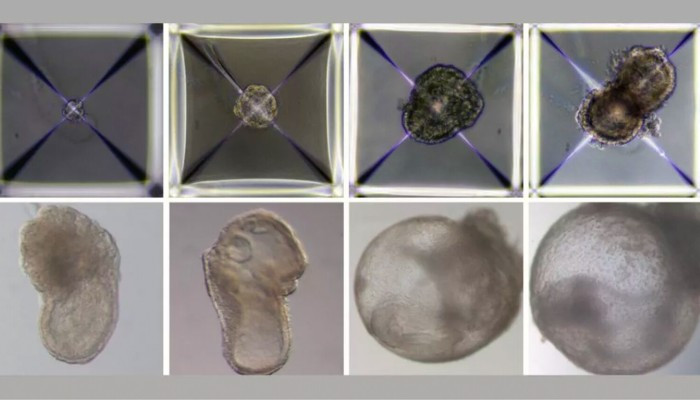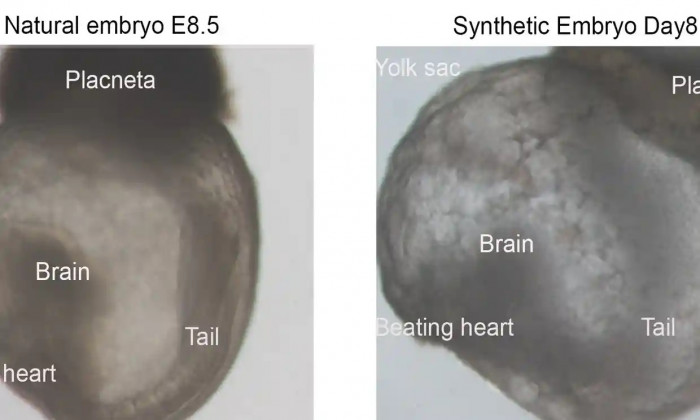Scientists create world’s first ‘synthetic embryos’
 Researchers have created the world’s first “synthetic embryos” in a groundbreaking feat that bypassed the need for sperm, eggs and fertilisation. Scientists at the Weizmann Institute in Israel found that stem cells from mice could be made to self-assemble into early embryo-like structures with an intestinal tract, the beginnings of a brain, and a beating heart. But researchers believe the work could also reduce animal experimentation and ultimately pave the way for new sources of cells and tissues for human transplantation. For example, skin cells from a leukaemia patient could potentially be transformed into bone marrow stem cells to treat their condition. “Remarkably, we show that embryonic stem cells generate whole synthetic embryos, meaning this includes the placenta and yolk sac surrounding the embryo,” said Prof Jacob Hanna, who led the effort. “We are truly excited about this work and its implications.” The work is published in Cell. Last year, the same team described how they had built a mechanical womb that enabled natural mouse embryos to grow outside the uterus for several days. In the latest work, the same device was used to nurture mouse stem cells for more than a week, nearly half the gestation time for a mouse. Some of the cells were pre-treated with chemicals, which switched on genetic programmes to develop into placenta or yolk sac, while others developed without intervention into organs and other tissues. While most of the stem cells failed to form embryo-like structures, about 0.5% combined into little balls that grew distinct tissues and organs. When compared with natural mouse embryos, the synthetic embryos were 95% the same in terms of their internal structure and the genetic profiles of the cells. As far as the scientists could tell, the organs that formed were functional. Hanna said synthetic embryos were not “real” embryos and did not have the potential to develop into live animals, or at least they hadn’t when they had been transplanted into the wombs of female mice. He has founded a company called Renewal Bio that aims to grow human synthetic embryos to provide tissues and cells for medical conditions. Advertisement Dr James Briscoe, a principal group leader at the Francis Crick Institute in London, who was not involved in the research, said it was important to discuss how best to regulate the work before human synthetic embryos were developed. “Synthetic human embryos are not an immediate prospect. We know less about human embryos than mouse embryos and the inefficiency of the mouse synthetic embryos suggests that translating the findings to human requires further development,” Briscoe said. But, he added: “Now is a good time to consider the best legal and ethical framework to regulate research and use of human synthetic embryos and to update the current regulations.” Speaking to StatNews, Prof Paul Tesar, a geneticist at Case Western Reserve University, said the more scientists pushed stem cell-derived embryos further and further along the path of development, the more the synthetic and natural embryos begin to merge. “There will always be a grey area,” he said. “But as scientists and as a society we need to come together to decide where the line is and define what is ethically acceptable.” The creation of “synthetic” human embryos is outside of the legal framework of the UK’s Human Fertilisation and Embryology Act, but it would be unlawful to use them to establish a pregnancy in a woman, because they are not classed as “permitted embryos”. We believe everyone deserves access to information that’s grounded in science and truth, and analysis rooted in authority and integrity. That’s why we made a different choice: to keep our reporting open for all readers, regardless of where they live or what they can afford to pay. This means more people can be better informed, united, and inspired to take meaningful action. In these perilous times, a truth-seeking global news organisation like the Guardian is essential. We have no shareholders or billionaire owner, meaning our journalism is free from commercial and political influence – this makes us different. When it’s never been more important, our independence allows us to fearlessly investigate, challenge and expose those in power. Support the Guardian from as little as $1 – it only takes a minute. If you can, please consider supporting us with a regular amount each month. Thank you.  |

Japan Unveils Human Washing Machine, Now You Can Get Washed Like Laundry (video)
117401.12.2025, 20:45
Chinese humanoid robot sets Guinness World Record with 106-km inter-city walk (video)
82824.11.2025, 16:30
Musk։ Optimus will be able to eliminate poverty and provide everyone with a universal high income (video)
82323.11.2025, 12:45
AGMI researchers expose the hidden role of female perpetrators in the Armenian Genocide (photo)
80713.11.2025, 21:15
LVM3-M5 mission successfully launches CMS-03 satellite (video)
111902.11.2025, 21:17
Google разработала квантовый алгоритм, работающий в 13 тыс. раз быстрее алгоритма суперкомпьютеров
147722.10.2025, 23:44
